As the filmstack community continues to grow on Substack,
, author of Hope for Film, had the brilliant idea of “monthly challenges” that would allow individual writers and publications to contribute their ideas, answers, and perspectives to that month’s prompt. 1July’s challenge is brought to us by
, author of Anti-Brainrot:“For this challenge, you can choose to share either your favorite needle drops, composers, themes, monologues, usage of voice-over narration, or directors who use soundtracks to further their storytelling. Expand upon how these key moments of sound usage helped to shape a scene or contributed to the emotions you had while watching it.
It takes many departments to render the final form of a film. For my challenge, I want to focus on the sound department. There are three basic types of sound in cinema: dialogue (speech, voice-over narration), effects, and music. This challenge is designed to get you to think about an element in film that is invisible—but sound shapes the image as much as the image shapes sound.1 Without sound, movies lose much of their emotional impact. It shapes a film in subtle and almost subliminal ways that have a marked effect on how a viewer interprets the image they're seeing.”
-NYT 100 Best Films List: My Personal Top 10 Movies That Defined Cinema Since 2000 + A FilmStack Challenge by Swabreen Baker
In my professional opinion, when watching a movie, it should be loud. Not “loud enough.” I’m talking loud as fuck.
You see, the optimal conditions for cinematic immersion should engage your eyes and ears in equal measure. Film is, after all, an audiovisual medium, and its sonic dimension is as deliberately crafted as its visuals.
Speaking from experience, some of the most transcendent experiences I’ve had as a viewer were triggered by sound — the perfect needle-drop at the perfect moment, the incorporation of voice-over in unexpected ways, or a beautifully composed musical score whose sonic subtly opens my emotional floodgates, but would be nigh on imperceptable at a lower volume.
TAP INTO FILMSTACK BY SUBSCRIBING:
And so, Acquired Tastes is proud to present its response to Filmstack Challenge #4, featuring examples from three of my favorite films!
Silence & Score in Columbus (2017)
Kogonada’s debut film, Columbus, is nothing short of a masterpiece. It is the story of Jin (John Cho), who arrives in the town of Columbus, Indiana, after his father, a professor of architecture on a lecture circuit, falls ill. The relationship between father and son is emotionally complicated, which makes Jin’s stay in Columbus, a little-known mecca of modernist architecture, personally fraught.
Jin meets Casey (Haley Lu Richardson), a lifelong resident of the city who has chosen to forgo life beyond Columbus to continue caring for her mother. Casey works at the local library and has a profound appreciation for her surroundings, admiring the architecture and taking the time to learn all about the city she intends to call her lifelong home.
Jin and Casey, both lost and lonely souls, get to know each other through a series of conversations while touring the town’s architectural landmarks. It’s magnificent from start to finish, but one moment in particular exemplifies Kogonada’s brilliance: the scene where Casey takes Jin to the modernist bank.
In an earlier scene, Casey takes note of a guide speaking to a group of tourists. He says:
“This is the Irwin Conference Center, formerly the Irwin Union Bank. It was completed in 1954 and designed by Eero Saarinen, son of Eliel Saarinen, who designed the First Christian Church. Now, like the church, banks in the U.S did not look like this in 1954. They were big, imposing buildings that had tellers behind bars…”
Later, when Casey shows the building to Jin, something remarkable happens:
As Casey recites facts about the bank, we see her and her reflection in the glass as if she’s talking to herself. Jin interrupts, telling her to “stop with the tour guide mode.” Casey claims she’s not “in a mode,” but we know she’s being dishonest. Jin asks what moves her about the building and she tells him, but Kogonada doesn’t let her tell us. Instead, all sound drops, and the camera is relocated, placed inside the bank, looking directly at Casey through the glass.
The building’s distinctive windows form an invisible cinematic barrier blocking sound and rendering Casey inaudible. Instead, the film’s soothing score quietly swells. The intimacy of the moment is amplified by our exclusion. Whatever Casey says remains between her and Jin, as architecture and cinematic language intersect, with Kogonada utilizing silence and a soft musical score to communicate more than words ever could.
Voice-Over & Cinematic Montage in 20th Century Women (2016)
Longtime readers of Acquired Tastes know that 20th Century Women is my favorite film, and that I won’t stop talking about it until I die. This month's film challenge, with its focus on voice-over, provides me with another opportunity to extol the film’s brilliance.
It’s the story of Dorothea Fields (Annette Bening), a single mother raising a teenage son, Jamie (Lucas Jade Zimmerman). Living in a group-share domestic environment, she enlists the help of her tenant, Abbie (Greta Gerwig), and her son’s best friend, Julie (Elle Fanning), to help raise Jamie. It’s an experiment in a counter-cultural conception of child-rearing, organized around the question, “How do you be a good man? What does that even mean nowadays?”
“Don’t you need a man to raise a man?” Julie asks, with heavy skepticism.
“No, I don’t think so,” Dorothea replies, “ I think you’re what’s gonna work for him.”
So begins Jamie’s introduction to the female experience via Abbie, a second-wave feminist immersed in the punk scene, and Julie, Jamie’s closest friend and object of his deepest yearnings. What could possibly go wrong?
“It’s 1979…”
Despite taking place in a very specific time and place—Santa Barbara, 1979—director Mike Mills employs voice-over throughout the film in a way that transcends time and space, allowing the film to function in “narrative flexitime” and creating a singular limited first-person omniscience.
Consider the scene where Dorothea (Annette Bening) gets her first glimpse of the punk scene her son idolizes. Her internal musings, conveyed via voice-over narration, speak to her vexatious attempt to bridge the inter-generational gap between mother and son:
The trifecta of Mills’ visual montage, Benings’ tender yet wry intonation, and the film’s serene score by Roger Neill creates a moment capable of reflecting the beginning of nascent counter-cultural movements and the end which looms just beyond that particular moment in time and space.
When she gets home, her son sits on the couch like a parent waiting for a teenager out past curfew. He asks her about her experience. She replies, dreamily, “It was life-changing.” She isn’t lying, nor is she telling the whole truth.
Dorothea’s reflections on the present and future pull into stark relief the fact that she’s a product of an era long since past. After telling Jamie her evening was “life-changing,” a mere thirty-five minutes into the film, she reflects on the death that awaits her, twenty years in the future, as she smokes a cigarette alone in her bedroom, staring off into space.
Her awed, melancholic musings about what the future holds are kept private from everybody except us, the viewers, who are granted deeply personal insights through the magic of voice-over narration.
“It Hurts to be Alive and Obsolete”
Voice-over also facilitates the incorporation of the feminist texts whose ideas are influencing Jamie, per the experiment Dorothea designed. This allows us, the viewer, to consider the text’s content alongside Jamie.
In the film’s latter half, Jamie reads Dorothea a passage from a Zoe Moss essay titled, “It Hurts to Be Alive and Obsolete.” In this instance, we’re not only processing the text alongside Jamie, but also alongside Dorothea, whose experience and interpretation of the text diverge from Jamie’s in deeply personal ways.
At the end of the passage, in a soft, controlled tone, Dorothea asks, “You think that’s me… You think you know me better because you read that?” Jamie stammers no, clearly caught off guard by her response. In his attempt to relate to his mother, he’s clearly offended her.
While Dorothea's assertion that “she doesn’t need a book to understand herself” may or may not be true, it’s a simultaneous rejection of Jamie and the text, but not for a lack of resonance. To the contrary, Dorothea’s experiment in “raising a good man” has not only allowed Jamie to see his mother in a new light, but to see through her contented facade.

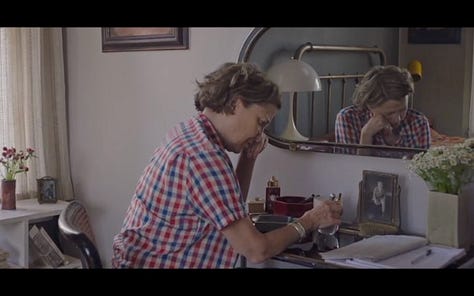

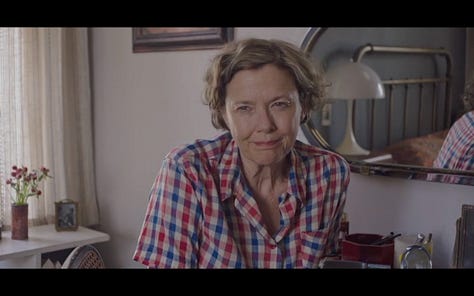
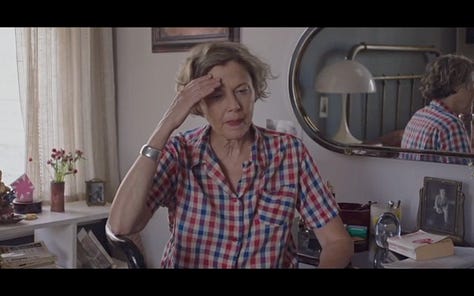
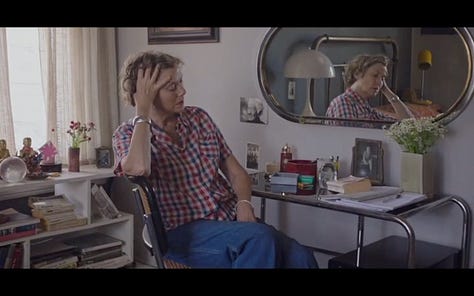
She’s unsettled by the notion that the student has become the teacher — that is, Jamie can offer an incisive articulation of what it’s like to be an aging woman to his mother. The power dynamics have inverted, and she doesn’t just feel seen, she feels exposed.
That’s why in the following scene, she calls off her experiment, telling Abbie that Jamie isn’t ready for “hardcore feminism,” making an absurd comparison between the humanizing insights of second-wave feminist literature and the dehumanization of pornography… all of which is made possible by the use of voice-over throughout 20th Century Women.
Soundtrack and the Non-Diagetic Musical Booksmart (2019)
Booksmart, Olivia Wilde’s directorial debut, has been described as “Superbad for girls.” I admit that there are obvious narrative and thematic parallels between the two films, but the comparison does not do Booksmart justice.
Booksmart is a funnier Superbad for the girls, gays, and theys. The chemistry between Wilde and her ensemble cast is lightning-in-a-bottle, and, despite having seen it eight times, it makes me laugh every time. Yet what I find most remarkable about Booksmart is its soundtrack, carefully curated and cleverly employed by Wilde to create a non-diagetic pseudo-musical.
In traditional musicals, songs serve as a means for characters to convey their emotions to the audience. While characters in Booksmart don’t sing2 or dance,3 the soundtrack’s needle drops essentially serve the same function. Is Booksmart intended to be a musical? No, but the film’s soundtrack is interwoven into the emotional fabric of the film to exceptional effect.
Let’s consider a few examples:
Amy’s Reverie
At the beginning of the film, when Molly (Beanie Feldstein) and Amy (Kaitlyn Dever) are at lunch, an intrusive music cue introduces Amy’s love interest, Ryan (Victoria Ruesga).
The song that plays, “Can You Discover?” by Discovery, combined with close-ups of Ryan, plunges the viewer into Amy’s romantic reverie. Molly must notice Amy is distracted because she interrupts the music, pulling Amy back to reality, to suggest coerce Amy into talking to Ryan. When Amy agrees, she gets up from the table and the music resumes,4 giving the impression of butterflies as she approaches, until her clumsiness breaks her reverie, bringing her firmly back to reality for an awkward interaction.
Gigi’s Graceful Entry
Moments later, “Money” by Leikeli47 introduces us to my favorite character, Gigi (Billie Lourde):
The lyrics introduce us to “the 1%,” as Amy derisively labels her. Sitting out the window of a car, Gigi magically glides into the film via a hood-mounted shot, her hair blowing in slow motion. The song gives partygirl, but the visuals lend an otherworldly grace perfectly suited to Gigi, who acts as a sort of spirit-guide for Molly and Amy throughout their pre-graduation odyssey, reappearing in unexpected places in ways that seemingly confound time and space.
There are so many more examples of Booksmart’s soundtrack operating with maximum effect: arriving at Nick’s party to “Look at These Hoes” by Santigold, whose rapid percussion feels like an elevated heart rate as our protagonists approach their proverbial gates of Oz; Ms. Fine (Jessica Williams) entering the high-school party to the tune of “Boys” by Lizzo, a track with a steamy bounce that tastes of liquor and sexual disinhibition; unexpected hook-ups on the bathroom floor to the sultry crooning of “Cold War” by Cautious Clay; dangerously drifting through the streets to the explosive sound of DJ Shadow’s “Nobody Speak ft. Run the Jewels;” the reassuring whispers of “Oh Baby” by LCD Soundsystem that underscore Molly’s reconciliation with her rival, AAA (so named for giving three senior boys “road-side assistance”); and, of course, the joyous liberation of “Slip Away” by Perfume Genius that accompanies Amy’s dive into the pool, a moment of ecstasy that gives way to devestation communicated by Dan the Automator’s score:
Time and again, the music in Booksmart immerses the viewer in the mood of the moment, with an impact that surpasses a standard soundtrack found in typical raunchy high-school comedies, transforming the film into a non-diagetic pseudo-musical.
Thank you for reading Acquired Tastes, my fellow Film Freak!
What are your favorite uses of sound in movies?
Don’t forget to subscribe, and I’ll see ya for the next one.
Here are links to Ted Hope’s first and second challenge, and the third, brought to us by
of That Final Scene.Except for a karaoke sing-along to“You Oughtta Know” by Alanis Morissette…
🎶 Oh baby baby baby, please, my heart sinks to my knees. Oh baby baby do you know I think about you nightly? 🎶




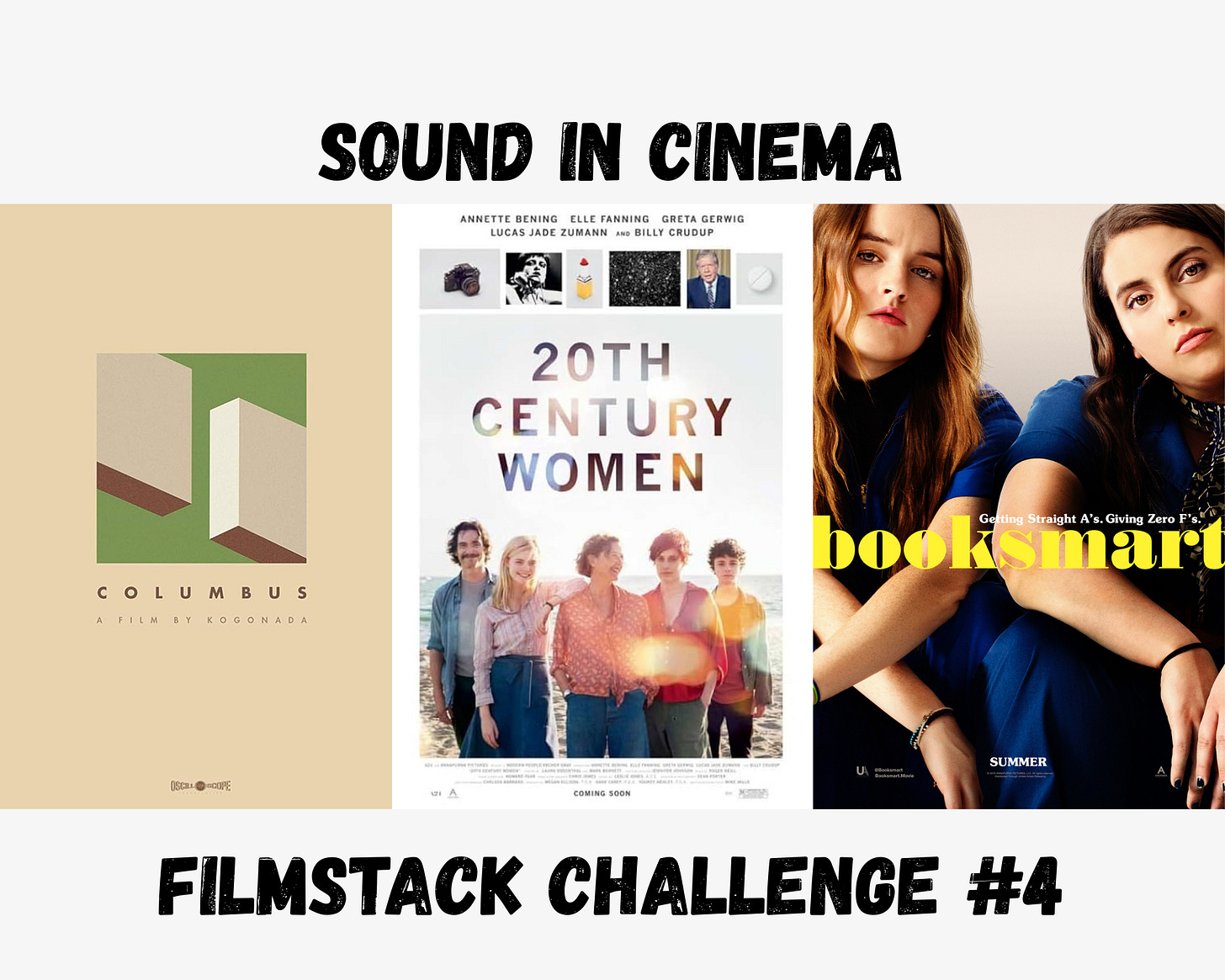


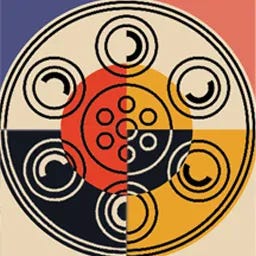
Oh this was fun to read! I'm adding 20th Century Women to my watchlist.
The Booksmart example reminded me of how music really helps define certain experiences relating to love and having a crush.
The editing in that Columbus clip is so so good! Very emotionally moving.
As a sound professional in audio, I completely disagree 100% that sound should be "loud as fuck" in movies. Loud for louds sake serves no purpose other than numbing the audience to the point where you might as well have no sound at all. It's like movies where the score never ends. It becomes meaningless. If you need your film to be loud for louds sake, then you're trying to make the sound do something the movie itself is not capable of delivering.